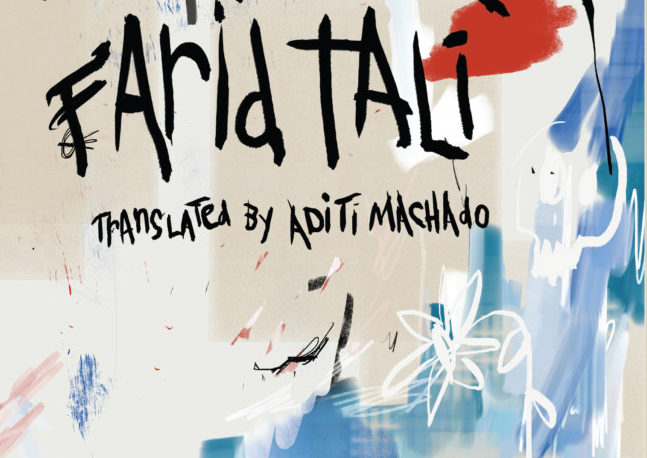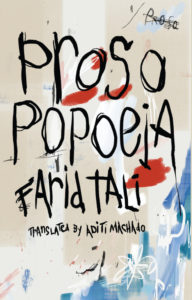

The author of Prosopopoeia Farid Tali, provides clues to his readers about what he is going to offer even before one opens the book—the title literally means “a figure of speech in which an imagined or absent person or thing is represented as speaking.” Then there is the foreword, a poem by Jean-Baptiste Chassignet (1594) that opens with, “Mortal, think: what’s under a charnel’s lid: / a worm-bitten corpse, bare of nerve and.”
Prosopopoeia is the charnel house whose lid we are opening, and the absent person we are going to face could be the corpse, or rather the person that is Hakim Tali, who is dying who is dead who is the corpse that is decomposing, turning into the composing members of its breathing existence that once-upon-a-time was whole. But now it is decomposing, decomposing until it is no more and gives way to other bodies, bodies that are sexual agents, observed and entangled: the body of the narrator of the book, perhaps Farid Tali himself, and that of his lover, a man called by the same name as his brother’s But this giving way is no disappearance, it is the dead and his body and his memory acquiring new positions and meanings for the narrator: “All that is over, I said to myself. Not that it had actually ceased to exist—on the contrary, it does in fact exist somewhere and is more real than anything claiming existence—but rather that the slow (the at first slow but then very swift) combustion had forever ceased” (2).
The opening of the novel looks back to the period immediately following the loss of the brother, and is divided into two types of chapters: the ones printed in normal font, and the italic ones. The former are the narrative ones, in which the narrator tells us about the grieving and the mourning, contemplating this loss and the very material of the human body, which in turn becomes the focus of the italic chapters of the book. The human body, as flesh as carnal as it can be, is dissected part by part, member by member—the head, the bones, the skin, the hands, the fingers, the thighs, the lips, the blood, the chin, the neck, the knees, the toes, the nails, etc.—as if Tali is copying the very process of the corpse decomposition, or the mother’s lamentation “one after the other, every part of his body was named, and with them, memories, images, precise evocations. My son is dead, never again shall I touch his hair, my son is dead, never again shall his eyes twinkle …” (3), or as if he wants to celebrate, praise, acknowledge their role in the whole, giving voice to each and every one of them and bringing them back to life.
As we move to the second part of the novel, the alternation between the normal font and italics becomes seemingly arbitrary, and the two begin to be completely interwoven within each chapter as the body of the narrator and his lover lie in front of us in naked intimate moments of a sexual embrace. “His body possessed the same fullness as did my desire for him. I would caress his legs which were firmly supported by his feet His feet, toward which my gaze falls, are shod, but it is not necessary to see them to know that they are there” (60).
We begin by accompanying Tali, or his narrator, through this painful process of digesting and mourning the loss of a person, a body, a brother—and later transition with him into discovering and receiving other bodies, strangers, and finally loving the beloved who shares the name of the brother:
And soon even familial bodies will be death, so much so that I will stop touching them, I’ll want to see them as little as possible, while on the other hand I will have much shorter, but more profound, embraces with those unfamiliar bodies. And I will think it normal because the unfamiliar is family, I will say. What will not be unfamiliar, and I will realize this, and it will surprise me, will be those bodies that I embrace, which I will think of as my own body, so that I won’t have any qualms going fast with them (46-47).
To seduce us into following this journey, Tali creates suspense by holding on to information. He doesn’t lay it all bare from the very beginning. Tali starts by using either “a” or “the” to introduce the family members, leaving us wondering what the narrator’s relationship is to this family, who has lost someone. It is only later and gradually that “the mother” becomes “my mother” or “the sister” becomes “my sister,” and that we realize the lost son is his brother.
Tali uses a similar strategy to reveal details of the narrator’s identity and culture. It is gradual, embedded into the narrative procession, never direct or informational. If you are Muslim or aware of Islamic funerary ceremonies, you might pick up on his emphasis on the mother’s lamentation in the opening pages, or on hints like the “Forty days” of mourning on page three; otherwise it will be a while before he mentions for example the “Quran” on page sixteen of a sixty-five-page story, or “Morocco” or “circumcision” on page twenty-two. But this is not a forced withholding; it is a natural part of this mysterious visitation of a painful past, a visitation that is not, and cannot be, chronological.
This fluidity in time is in fact just one of the structural and stylistic choices that Tali makes in order to craft his form to be beautifully in conversation with the themes he is addressing and the situations he is recreating. When one remembers or thinks about the loss of a close person, time becomes a vague concept. One constantly moves back and forth, revisiting certain moments and getting as close as one can and expanding on them (perhaps this is why some chapters begin with a sentence from previous chapters); or one distances oneself completely from the lost beloved and his memories and the memories of his loss (perhaps this is why the narrator tells us here and there that he was not there to witness the death and was informed, though one cannot be certain to trust him).
Another stylistic choice that is a reflection of the content is the rhythm of the sentences. Their high and low, their continuation and chain-like quality, their circularity–they all remind one of the very lamentation and singing of the mother and all other women taking part in the funeral, and of the voices of the old men sitting in a circle and reciting verses from the Quran, which the narrator doesn’t understand but can feel the beauty of with all of his being.
With regard to the translation of the text, there are places in the novel where one might pause on a word or a punctuation choice (for example on comma splices), wondering about the original and the translation and their relationship, but those moments need not bother us. Translator Aditi Machado provides us with a “Translator’s Note” at the end, in which she explains her process and choices in the face of the beautiful challenge that was Tali’s work, and these can clarify for us her reading of the work and some of her choices for translation.
Farid Tali’s Prosopopoeia is a gorgeous memorial for a lost loved one, from one brother to another, from one man who finds beauty and love in the arms of another man to the one who died of HIV as a result of drugs. But more importantly, it is an intimate tribute to the human body, to its being of flesh and blood and to its encompassing mind and emotions, to its death and decomposition and its sex and resurrection, to its breaking from tradition and to its finding it anew. Prosopopoeia is a tribute so painfully beautiful you need to take breaks from reading it, because your body might not be able to contain all that its body contains and offers you.
Reviewed by Poupeh Missaghi
Poupeh Missaghi is a writer, Persian < > English translator, and Iran’s Editor-at-Large for Asymptote. A Ph.D. graduate from University of Denver’s Creative Writing Program, she has published work in Entropy, The Brooklyn Rail, Feminist Wire, World Literature Today, Guernica, Quarterly Conversation, Asymptote, and elsewhere. She lives in New York.
Prosopopoeia
by Farid Tali, translated from the French by Aditi Machado
Action Books
Paperback / 86 pages / 2016
ISBN: 978-0900575945
To read more book reviews, please click here.
Published on February 1, 2017.




